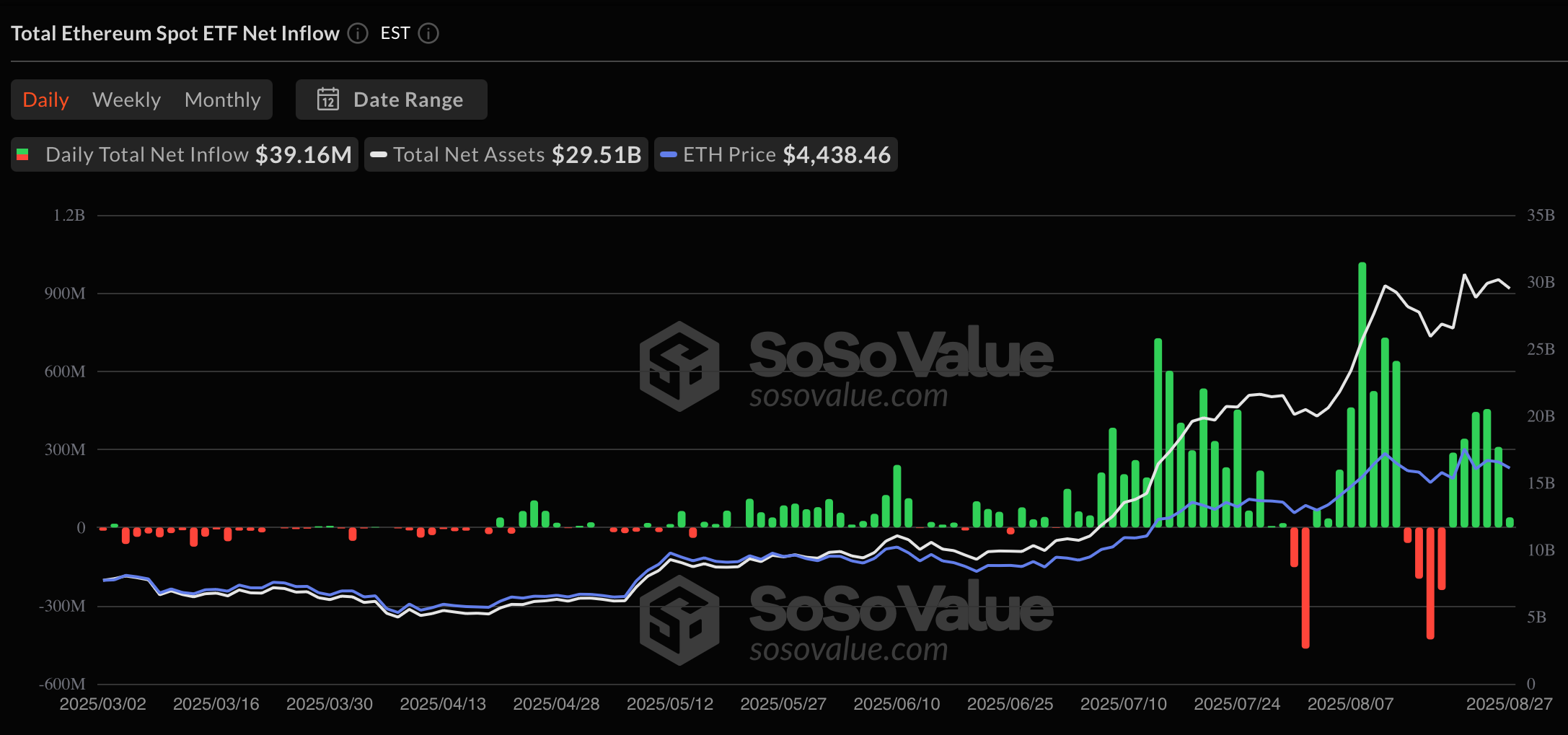- •A $1.1B Bitcoin whale transfer highlighted the institutional capital shift to Ethereum.
- •Ethereum ETFs reached $13.7B in inflows, while corporate treasuries now hold 4.4M ETH.
- •Nearly 30% of ETH supply is staked, generating $89B in annualized yields.
- •BitMine Immersion has become the largest ETH treasury holder with $8B worth of ETH.
- •Regulatory clarity and upgrades like Fusaka strengthen Ethereum’s long-term adoption outlook.
The institutional capital shift to Ethereum marks a defining moment in digital assets. Once dominated by Bitcoin, institutional flows now show Ethereum emerging as a preferred choice for yield, utility, and regulatory certainty.
A Major Shift in Institutional Allocation
In late August 2025, a Bitcoin whale transferred $1.1 billion into Ethereum. The move underscored a wider rotation in institutional strategies, with capital flowing from Bitcoin into Ethereum. On-chain data highlights that large holders are increasingly favoring Ethereum, not only as a speculative asset but as infrastructure supporting decentralized finance and real-world tokenization.
This shift aligns with Bitcoin’s declining market share, now at 58.6%, while Ethereum continues to absorb institutional attention. Analysts note that the comparison between Bitcoin as “digital gold” and Ethereum as a “productive asset” is becoming clearer in institutional portfolios.
Ethereum’s Yield and Utility Advantage
One of Ethereum’s key draws is its yield potential. Around 30% of the total ETH supply is staked, locking more than 36 million tokens into the network. These deposits generate approximately $89 billion in annualized staking yields, creating a consistent income layer that Bitcoin does not offer.
Beyond staking, Ethereum secures $3.2 trillion in total value locked across decentralized finance platforms. Stablecoins issued on Ethereum, including USDC and DAI, have become central to global liquidity. Together, these elements make Ethereum a dual-utility asset, a vehicle for both appreciation and productivity.
ETFs and Corporate Treasuries Add Fuel
The growth of Ethereum-focused exchange-traded funds (ETFs) has accelerated the institutional pivot. By late August 2025, Ether ETFs recorded $13.7 billion in net inflows, up sharply from $9.5 billion earlier in the month. Corporate treasuries have followed suit, collectively holding 4.4 million ETH, or about 3.7% of supply, valued at more than $19 billion.

Source: SoSoValue
Standard Chartered’s head of digital assets research has emphasized that treasury firms represent a long-term buyer base, unlikely to sell during short-term price swings. This steady demand highlights why institutional interest in Ethereum may prove more resilient than in past cycles.
Balancing Growth and Challenges
Despite the strong inflows, Ethereum faces challenges. The network’s validator exit queue reached nearly $5 billion in pending withdrawals, stretching wait times to over 18 days. While such exits could introduce temporary selling pressure, analysts argue that institutional inflows from ETFs and treasuries outweigh these risks. Large capital vehicles continue to absorb available supply, reducing the long-term impact of withdrawals.
BitMine and the Treasury Playbook
BitMine Immersion Technologies has emerged as the largest Ethereum treasury company, with more than 1.7 million ETH on its balance sheet. The firm’s strategy mirrors MicroStrategy’s Bitcoin model, but with a focus on Ethereum’s staking yields and DeFi growth.
BitMine has acquired nearly $8 billion worth of ETH and aims to control up to 5% of the circulating supply. The company’s stock now acts as a proxy for institutional investors seeking Ethereum exposure without direct token ownership. Combined with ETFs, these strategies have tightened Ethereum’s liquid supply, potentially setting the stage for further price pressure.
Regulatory and Roadmap Tailwinds
Ethereum’s regulatory clarity has also contributed to its rising institutional role. In 2025, the U.S. Securities and Exchange Commission classified ETH as a digital commodity, removing legal uncertainty and opening the door for banks and asset managers. The passage of the GENIUS Act, setting standards for stablecoins, has further strengthened Ethereum’s ecosystem.
On the technical front, Ethereum is advancing its roadmap with upgrades such as the Fusaka hard fork, aimed at improving data availability and validator usability. Restaking protocols like EigenLayer and continued growth of Layer 2 networks are also generating additional revenue streams and reinforcing Ethereum’s position as a settlement layer.
Closing Thoughts
The institutional capital shift to Ethereum is no longer speculative, it is visible across whale transactions, ETF inflows, treasury holdings, and regulatory support. While challenges such as validator exits and market volatility remain, the structural drivers of institutional adoption suggest that Ethereum’s role as a powerhouse in global finance is strengthening. For many investors, the story of 2025 may be remembered as the year institutional capital shifted decisively to Ethereum.
- Coin World – Ethereum Surpasses Bitcoin as Institutional Capital’s New Powerhouse
(Aug 29, 2025) - Cointelegraph – Ether ETFs hit $13.7B as inflows surge and corporate treasuries grow
(Aug 28, 2025) - Cointelegraph – Bitcoin whales rotate into Ether, despite record $5B ETH validator exit queue
(Aug 28, 2025) - Motley Fool – Why Ethereum’s Rally to $7,500 Makes BitMine Immersion a Must-Buy Stock Now
(Aug 29, 2025)







